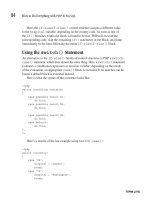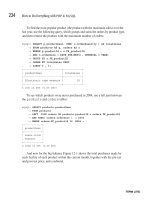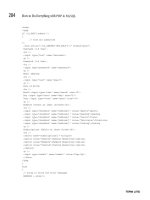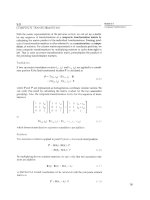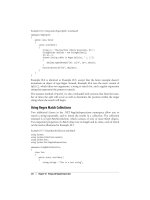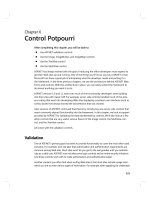Life with gmail phần 6 pot
Bạn đang xem bản rút gọn của tài liệu. Xem và tải ngay bản đầy đủ của tài liệu tại đây (804.11 KB, 10 trang )
poll mail.example.net proto pop3 nodns
user dsill with password flubgart is dave here
fetchall forcecr
This instructs fetchmail to connect to mail.example.net via POP3, log in as user dsill, password
flubgart, retrieve all messages, and deliver them to dave@localhost. The forcecr causes
fetchmail to end each line with a carriage return when injecting the message on the local system via
SMTP. qmail requires this.
5.3.2. getmail
getmail is a program that retrieves mail from a POP server and delivers it to a maildir mailbox. It's
actually a Python script, so you may need to install the Python interpreter before you can use getmail
getmail was written by Charles Cazabon, who maintains a web page for it at
/>5.4. Multi-RCPT vs. Single RCPT delivery
Say you're an MTA, and one of your users sends a message to three people on hostx.example.com.
There are several ways you could do this.
You could open an SMTP connection to hostx, send a copy of the message to the first user,
send a copy to the second user, send a copy to the third user, then close the connection.
1.
You could start three processes, each of which opens an SMTP connection to hostx, sends a
copy of the message to one of the users, then closes the connection.
2.
You could open an SMTP connection to host, send a copy of the message addressed to all
three users, then close the connection.
3.
The first method is clearly inferior to the third. Even if the message is tiny, it'll take at least as long.
And if the message is large, it'll take a lot longer and use more network bandwidth.
So scratch that one.
The second and third methods are a little more interesting.
The third method only opens one connection to hostx, and only sends one copy of the message. That
makes for efficient use of bandwidth.
The second method uses multiple connections and sends multiple copies of the message. That
"wastes" bandwidth, but due to the nature of the SMTP protocol, requires fewer round-trip delays, and
is faster than the third method. It's also simpler than the third method, so the MTA can be coded in a
more straightforward manner. And finally, because each recipient gets their own copy of the message,
it's possible for the MTA to implement VERPs (see next section).
qmail always uses the second method (single RCPT). There are no patches to implement the third
method (multiple RCPT) it would require major work.
Although there are pathological cases where it can be slower than multiple RCPT, the simplicity and
VERP advantages outweigh that overall.
Life with qmail
5.3. POP and IMAP clients 45
Single RCPT delivery does use more bandwidth than multiple RCPT delivery, but the difference is
often exaggerated. Most messages have, at most, a couple recipients, and they're usually on separate
hosts, so multi-RCPT delivery buys them nothing. Even on a list server, where multi-RCPT delivery
could help, the potential gains are small because SMTP uses only a fraction of the bandwidth over
most links HTTP usually gets the lion's share.
For example, if 10% of your uplink's bandwidth goes to SMTP, and your SMTP bandwidth could be
reduced by, say, 25%, by using multi-RCPT delivery, that would only drop your SMTP bandwidth to
7.5%.
5.5. VERP
When a message is undeliverable, the MTA responsible is supposed to return a bounce message to the
envelope return path (ERP). The bounce message should include the address of the recipient, the
reason the message is undeliverable, and whether the problem is temporary or permanent. Some
MTA's don't do the right thing, though. They might send the bounce to the address in the From header
field, or the bounce might not identify the recipient.
For most user-to-user messages, these problems aren't too bad. One can usually figure things out
based on the timing of the bounce or the contents. For mailing lists, the problem of bad bounces is
more serious. Subscribers move, forwarding mail to their new address. If the new address starts
having delivery problems, it can be impossible to tell which subscriber's mail is bouncing if the
bounce message only includes the new address.
Dan Bernstein came up with a solution to this problem called VERP (Variable Envelope Return Path).
Using VERPs, each message sent to each subscriber to a list has a unique return path. This allows a
bounce handler to identify the problem subscriber.
For example, a typical non-VERP'ed mailing list has a return address of the form
listname-owner@domain. For a VERP'ed list, the return address would look like
listname-owner-subscriber=sdomain@ldomain, where the subscriber's address,
subscriber@sdomain, is embedded between the "owner" and the "@". (The "@" in the
subscriber's address is replaced with an "=".)
The ezmlm list manager uses VERPs to automatically handle bounces. It even provides subscribers
with temporary delivery problems with a list of the messages they missed so they can retrieve them
from the archive.
Russell Nelson wrote a bounce manager for Majordomo under qmail, but he no longer maintains it.
It's available from />5.6. Troubleshooting
5.6.1. Processes
A properly-running, complete, but minimal qmail installation should always have the following four
processes:
qmail-send running as user qmails•
qmail-clean running as user qmailq•
qmail-rspawn running as user qmailr•
Life with qmail
46 5.4. Multi-RCPT vs. Single RCPT delivery
qmail-lspawn running as user root•
Depending upon your flavor of UNIX, one of the following two commands should list these
processes, and possibly a few more:
ps -ef | grep qmail
ps waux | grep qmail
For example:
[dave@sparge dave]$ ps waux|grep qmail
dave 2222 0.0 0.8 836 348 p4 S 10:25 0:00 grep qmail
qmaild 351 0.0 1.0 840 400 ? S N 12:43 0:00 /usr/local/bin/tcpserver -v -x /etc/tcp.smtp.cdb -u 49491 -g 31314 0 smtp /var/qmail/bin/qmail-smtpd-
qmaild 2220 0.0 1.0 844 420 ? S N 10:25 0:00 /usr/local/bin/tcpserver -v -x /etc/tcp.smtp.cdb -u 49491 -g 31314 0 smtp /var/qmail/bin/qmail-smtpd-
qmaill 365 0.0 0.8 748 344 ? S N 12:43 0:00 splogger qmail
qmailq 368 0.0 0.7 736 292 ? S N 12:43 0:00 qmail-clean
qmailr 367 0.0 0.6 732 272 ? S N 12:43 0:00 qmail-rspawn
qmails 350 0.0 0.8 776 336 ? S N 12:43 0:00 qmail-send
root 340 0.0 0.6 724 252 ? S N 12:43 0:00 /usr/local/sbin/supervise /var/supervise/qmail-send /var/qmail/rc
root 341 0.0 0.6 724 252 ? S N 12:43 0:00 /usr/local/sbin/supervise /var/supervise/tcpserver-qmail /usr/local/bin/tcpserver -v -x /etc/tcp.smtp
root 366 0.0 0.7 736 276 ? S N 12:43 0:00 qmail-lspawn ./Mailbox
[dave@sparge dave]$
If you run qmail or qmail-smtpd under supervise, as in the example above, you should see
those processes as well. And if run qmail-smtpd under tcpserver, you should see a parent
tcpserver process plus an additional tcpserver process for each active incoming SMTP
connection.
If you use splogger (or multilog or cyclog) to handle logging, you'll have a splogger (or
multilog or cyclog) process or two running as user qmaill.
Also, if qmail is busy delivering messages locally or remotely, you'll see up to
concurrencylocal qmail-local processes and up to concurrencyremote
qmail-remote processes.
5.6.2. Logs
5.6.2.1. multilog
multilog, which is part of the daemontools package, logs messages to a series of files in a
specified directory.
The log directory is specified on the multilog command line, so you can find it by examining your
qmail startup scripts.
The number of files in the log directory, and the maximum size of each file, are determined by
multilog options. The log file names are the TAI (Temps Atomique International) timestamps of
the time at which the file was started. The tai64nlocal command, also from daemontools,
converts TAI timestamps into local, human-readable timestamps.
A typical multilog log entry looks like:
Life with qmail
5.6. Troubleshooting 47
@4000000038c3eeb104a6ecf4 delivery 153: success: did_1+0+0/
"@4000000038c3eeb104a6ecf4" is the optional, but recommended, TAI timestamp. "delivery 153:
success: did_1+0+0/" is the log message itself.
5.6.2.2. splogger
splogger uses the syslog logging system to timestamp messages and send them to the syslog
daemon. Syslog is configured in /etc/syslog.conf. Messages sent to syslog have a facility and
priority. Entries in /etc/syslog.conf filter on the facility and priority to direct the messages to
the desired log file, remote log host, or the console. splogger logs to the mail facility, by default,
so grep'ing the syslog.conf file for "mail" should show the disposition of qmail's log messages.
Typical locations include:
/var/log/syslog•
/var/adm/SYSLOG•
/var/log/maillog•
A typical syslog log entry looks like:
Jun 3 11:35:23 sparge qmail: 928424123.963558 delivery 153: success: did_1+0+0/
"Jun 3 11:35:23" is the syslog timestamp.
"sparge" is the name of the system that sent the message.
"qmail:" is the tag splogger places on all qmail log entries.
"928424123.963558" is an optional TAI timestamp (see next section).
"delivery 153: success: did_1+0+0/" is the log message itself.
5.6.2.3. Log messages
Here's a typical log sequence for a message sent to a remote system from the local system:
1 @4000000038c3eeb027f41c7c new msg 93869
2 @4000000038c3eeb027f6b0a4 info msg 93869: bytes 2343 from <> qp 18695 uid 49491
3 @4000000038c3eeb02877ee94 starting delivery 2392: msg 93869 to remote
4 @4000000038c3eeb0287b55ac status: local 0/10 remote 1/20
5 @4000000038c3eeb104a13804 delivery 2392: success: 209.85.127.177_accepted_message.
/Remote_host_said:_250_CAA01516_Message_accepted_for_delivery/
6 @4000000038c3eeb104a4492c status: local 0/10 remote 0/20
7 @4000000038c3eeb104a6ecf4 end msg 93869
Line 1 indicates that qmail has received a new message, and its queue ID is 93869. The queue ID is
the i-node number of the /var/qmail/queue/mess/NN/ file the queue file that contains the
message. The queue ID is guaranteed to be unique as long as the message remains in the queue.
Line 2 says that the message is from and is 2343 bytes.
Life with qmail
48 5.6. Troubleshooting
Line 3 says qmail-remote is starting to deliver the message to , and it's assigning the
ID 2392 to the delivery.
Line 4 says 0 local deliveries and 1 remote delivery are pending.
Line 5 says delivery 2392 is complete and successful, and it returns the remote server's response,
which often contains information the remote mail administrator would find helpful in tracking a
delivery. In this case, the "CAA01516" is the remote system's delivery ID.
Line 6 says 0 local deliveries and 0 remote deliveries are pending, i.e., the delivery is complete.
Line 7 says that the message has been delivered completely and removed from the queue. At this
point, the queue ID, 93869, is reusable for another delivery.
5.7. Big Servers
See also qmail-ldap.
5.7.1. Scalable parallelism
Use a fast NFS network file server to store user directories. Set up multiple equal-preference SMTP
servers delivering to maildir mailboxes on the file server.
5.8. Migrating from Sendmail to qmail
Check Dan Bernstein's Sendmail->qmail page at />5.9. Mailing List Managers
Mailing list managers (MLM's) are systems that help list owners run mailing lists. Their duties fall
into two main divisions: managing the lists of subscribers, and controlling the resending of messages
to the subscribers.
Most (all?) UNIX mailing list managers can be made to work with qmail.
5.9.1. ezmlm
ezmlm was written by Dan Bernstein, the author of qmail. It was written for use with qmail, and relies
on several features of qmail. Most notably, it uses VERPs to reliably process bounce messages. ezmlm
is somewhat unique among MLM's in that it doesn't process commands sent to a central MLM
address: it appends the command to the name of the list. E.g., to subscribe to the
"" list, one sends a message to "".
For more information about ezmlm, see the unofficial ezmlm web site, and the
official home of ezmlm-idx, a very nice add-on that includes many useful features.
5.9.2. Majordomo
Majordomo is one of the most popular UNIX MLMs. It works fine with qmail provided a few simple
changes are made. Russ Allbery has written a FAQ about qmail/Majordomo available from
/>Life with qmail
5.7. Big Servers 49
5.10. Patches
Various source code patches are available for qmail. To install a patch, download it, cd to the qmail
source tree, and apply it using the patch command.
cd /usr/local/src/qmail/qmail-1.03
patch -p0 </tmp/patchfile
Note: See the patch man page for more information. This is just an example. Also, you might need
to use a current version of GNU patch to successfully apply some patches. See
/>Stop qmail by killing qmail-send or, if you installed the qmailctl script in the Installation
section, do:
qmailctl stop
Then rebuild and install the new binaries:
make setup check
And restart qmail:
qmailctl start
Finally, test qmail especially the part you patched.
Note: Although lists many patches for qmail, none of the them have been
approved by the author of qmail. They may introduce security, reliability, efficiency, or functionality
problems not present in qmail. Most qmail installations only require the some of the Recommended
patches. You should not install any patches that you don't clearly require.
5.10.1. Recommended Patches
qmail.org has a "Recommended Patches" section: These patches
address the few known bugs in qmail.
Note: all of the Recommended Patches have been included in the netqmail distribution. See
/>5.10.1.1. errno.h patches
This patch fixes a problem with missing errno.h inclusions. See
for a detailed explanation and the patch
itself.
Mate Wierdl has errno.h patches for all of Dan Bernstein's software including qmail, daemontools,
and ucspi-tcp. These patches are available from
/>Life with qmail
50 5.10. Patches
5.10.1.2. qmail-local TAB patch
This patch fixes a minor bug in the parsing of .qmail files that start with TAB characters.
/>5.10.1.3. IP 0.0.0.0 patch
This patch causes the IP address 0.0.0.0 to be recognized as local.
/>5.10.2. DNS
Historically, DNS responses have been limited to 512 bytes. Some large sites have started returning
MX responses longer than that. qmail and many other programs have a problem with Domain Name
Server (DNS) queries that return very large results. There are two ways to fix this in qmail and one
workaround that might be sufficient for some applications.
5.10.2.1. Christopher K. Davis' patch,
/>This is an adaptation of a patch by Chuck Foster that should work with any resolver library, no matter
how old, and uses a guard byte to avoid the "number of bytes placed in the buffer" library bug. It
reallocates only once, to 65536, rather than just to the size needed, so it can be less memory-efficient
than Chuck's patch (though, like his patch, it only reallocates if the response is larger than
PACKETSZ, which defaults to 512 bytes). After reallocating, it forces a TCP query, rather than
requiring the resolver library to do so (avoiding an extra round-trip between qmail and the name
server, though if they're on the same machine or local network this is not a big worry).
5.10.2.2. Bump the packet buffer size up to 65536
Works with recent BIND resolver libraries, which will automatically do a TCP query within the
library code if the reply comes back with the truncation bit set. This is the simplest fix, though it's also
potentially the most wasteful of memory, depending on how your system handles paging. To do this,
just replace PACKETSZ with 65536 in dns.c and rebuild qmail.
5.10.2.3. Run dnscache from djbdns
dnscache is, as the name implies, a caching DNS server. It knows how to handle large DNS
responses and removes unnecessary information from them, so the response it returns is usually much
smaller than the direct response. It also generally improves DNS lookup performance for all services
that use DNS. Because it doesn't require patching qmail, this might be an acceptable workaround.
Unfortunately, it's not a complete fix because responses can still be too large for qmail. See the djbdns
section under Related Packages for more information.
5.10.3. qmail-ldap
This patch, by Andre Oppermann, et al, implements Lightweight Directory Access Protocol (LDAP)
support in qmail. LDAP is like a network phone book. Using qmail-ldap, it should be possible for a
POP server to serve many thousands of users. See />Life with qmail
5.10. Patches 51
5.11. QMTP
QMTP is the Quick Mail Transfer Protocol, an SMTP replacement protocol designed by Dan
Bernstein. The protocol is defined at QMTP is similar to SMTP, but is
simpler, faster, and incompatible with SMTP. qmail includes a QMTP server, qmail-qmtpd, which
is run very much like qmail-smtpd. QMTP usually uses port 209.
qmail doesn't include a QMTP client, but the serialmail package does. maildirqmtp takes a
maildir mailbox and delivers the messages it contains to designated QMTP server via QMTP.
QMTP is not a drop-in replacement for SMTP, and is not yet in widespread use across the Internet.
Russ Nelson has a patch for qmail-remote that supports QMTP. It's available from
He also has a tarball that can be extracted in
/service to enable a QMTP service. It's available from />5.12. Rejecting Invalid Recipients During SMTP Dialogue
When a remote server connects to qmail-smtpd and offers it a message, qmail-smtpd checks
the recipient addresses against the contents of control/rcpthosts. If the host or domain after
the @ symbol is listed in control/rcpthosts, qmail-smtpd accepts the message, it's placed
in the queue, and qmail-send attempts delivery. If the local recipient is invalid there's no user or
alias by that name qmail-send generates a bounce message and sends it to the return address
specified during the SMTP dialogue.
In a well-behaved world, either strategy would be fine. Unfortunately, there are a lot of
poorly-behaved spammers out there. Some will attempt to deliver messages to recipients that "might"
exist on your server using a database of common names, a dictionary, or even a generated list of all
possible alphanumeric strings.
On a qmail system, such spam attacks can inflict a substantial load on the system, fill the queue with
junk, and delay the delivery of valid messages.
Some MTAs validate the local recipient during the SMTP dialogue and refuse to accept the message
if the recipient is invalid. This saves the server from a lot of unnecessary work, but has a negative side
effect, too. Using this validation, spammers can quickly determine which addresses are valid.
There are several ways to implement recipient validation during the SMTP dialogue with qmail. Eben
Pratt has assembled a list of them at Most of these solutions
require maintaining a database of valid or invalid recipients or patterns. One that doesn't is Paul Jarc's
qmail-realrcptto, available from ./qmail/.
5.13. TLS and STARTTLS
Scott Gifford has written a very thorough and detailed step-by-step guide to using transport layer
security (TLS) with qmail. The guide covers STARTTLS for SMTP and STLS for POP3D
specifically for netqmail. It's available at
/>Life with qmail
52 5.11. QMTP
A. Acknowledgments
First, thanks to Dan Bernstein for designing and writing such a powerful and elegant system. After
nearly ten years of use, qmail still impresses me.
I'd also like to thank the members of the qmail mailing list. Two members deserve special mention.
The first is Russ Nelson, one of the most helpful, patient, knowledgeable, and funny contributors. His
contributions to the qmail community are second only to DJB's. The second is Charles Cazabon,
who's close on Russ' heels. Charles is currently the major contributor to the mailing list, answering
more questions correctly than anyone else. Charles has also written a couple of very useful utilities,
getmail and pymsgauth, and was technical editor for The qmail Handbook where his contributions
were critical to the success of the book, and for which he has received too little reward and
recognition.
Thanks also to everyone who reviewed or contributed to this document, including:
Vince Vielhaber•
Chris Green•
Christopher K. Davis•
Scott Schwartz•
Fred Lindberg•
Russell P. Sutherland•
Alex Miller•
Tim Hunter•
Frank D. Cringle•
Mahlon Smith•
Rogerio Brito•
Tony Hansmann•
Matthias Andree•
Tillman Hodgson•
Stefan Witzel•
Scott Gifford•
too many others to mention •
Special thanks to Henning Brauer for donating the lifewithqmail.org domain and hosting it!
Special thanks also to Michael M. Kadrie of ATLAS Design Group,
, for the nifty new qmail logo!
Life with qmail was written using Simple Document Format (SDF), a very cool Perl-based markup
language that generates HTML, plain text, PostScript, POD, and other formats. It made the job much
easier. See for more information.
A. Acknowledgments 53
Life with qmail
54 A. Acknowledgments




